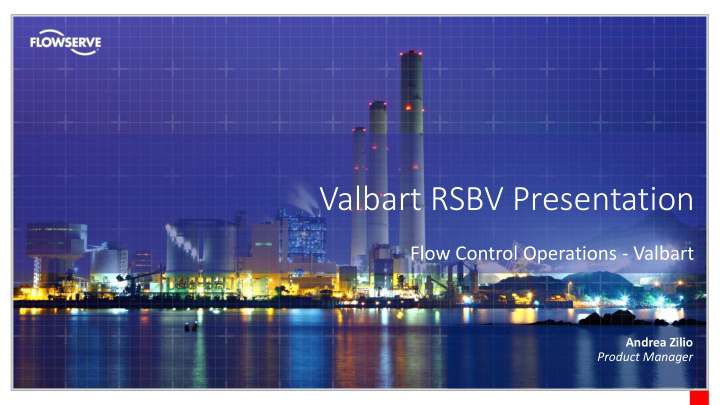



Valbart RSBV Presentation Flow Control Operations - Valbart Andrea Zilio Product Manager
VALBART RISING STEM BALL VALVES
RSBV overview • The RSBV is designed specifically for critical and severe services, everywhere there are solid particles combined with frequent mechanical and thermal cycling. • Its unique feature is the helix system that opens and closes the valve without stem rotation. • By design, the ball is not in contact with the seat as it moves in and out of the open or closed position (friction-free movement). • The RSBV design has maintenance-friendly features. The stuffing box-type gland packing (including gland and gland flange) remains accessible and thus eliminates the need for special tools when adjusting or repacking the stem seal.
RSBV applications Rising stem ball valves are primarily used in the oil&gas and petrochemical industry. Applications include: • Molecular Sieve dehydration switches • Meter isolation • Block and bypass • Steam and Gas • Product segregation • Dryer switching
RSBV applications – gas treatment facilities- mol sieve units Molecular sieves have been used in the natural gas processing industry for many years to purify and dehydrate natural gas. Molecular sieves are the product of choice for the deep dehydration required by LNG (Liquefied Natural Gas) or NGL (Natural Gas Liquids) facilities. The active constituent of a molecular sieve adsorbent is a microporous, crystalline, alkali-metal alumino-silicate, referred to as a zeolite. Originally discovered as minerals in nature, zeolite crystals are now grown synthetically under carefully controlled conditions to yield a product of very high purity and precisely uniform properties.
RSBV applications – gas treatment facilities- mol sieve units Valve characteristics and requirements: 1.Valves must be tight shut off to ensure full regeneration cycles, any seat leakage may cause the increase of cycle length. 2.Valves must withstand high working temperatures of 280-310 ◦ C. and must be designed for 426 ◦ C. 3.Valve must be suitable to withstand the fluctuating temperatures and temperatures for the system that is usually cycling the valves each 8 hours continuous every day 24/7 and normally 5 years before maintenance. This concludes that the rising stem ball valves are facing 5500 cycles between repairs. Molecular Sieve Units are used for any plant that uses natural gas 4.Valves must be suitable to withstand some degree of as the feed stock. These units are basically drying the natural gas dust particles entering from the reactors from liquids and production of LNG. Many valve types have been tried to be used for this application, however the rising stem ball 5.Valves are usually equipped with pneumatic linear valve has a superior and proven track record. actuators (switching valves)
RSBV applications – gas treatment facilities - LNG and GTL LNG: GTL: Liquefy natural gas at minus 162 Converting natural gas to other degrees C to make it suitable for gaseous (longer chain) hydrocarbons transport and storage, volume is 600 such as gasoline and diesel fuel (Mobil times less than in gaseous form. or Fischer-Tropsch processes)
RSBV applications – other applications Other than mol sieve, RSBV has a wide range of applications on which the valve can be applied. RSBV is the right choice whenever you have one or more of the following conditions: • Frequent mechanical cycling with reduced maintenance • Frequent thermal cycling – applicable range -196 ° C to 500 ° C even with the same valve • Presence of dirty particles in the fluid
RSBV applications – other applications - Refinery Furthermore, RSBV valves are widely used in REFINERY market because of the following characteristics: 1. Seat tightening can be operated from the exterior of the valve by increasing torque on the multi turn operator or thrust on linear operator. 2. No “sticking” effect as ball is retracted from the seat. 3. No contact during open-close operation, non-rubbing between ball and seat assuring very low maintenance, reliable and long life. 4. Top entry design for inline inspections and maintenance, valves do not have to be removed from the line. 5. No valve cavity due to single seat design.
RSBV technical features
Part.No Description Standard Material 1 Body Cast ASTM A351 Gr.CF8M or forged ASTM A182 F316 2 Bonnet Cast ASTM A351 Gr.CF8M or forged ASTM A182 F316 3 Ball Cast ASTM A351 Gr.CF8M+Stellite (weld overlay) or forged ASTM A182 F316+Stellite (weld overlay) 4 Rollpin Stellite12 (up to 6"), XM19 + Stellite weld overlay (8" and above) 5 Helix coil stem Alloy steel ASTM A564 Gr.630 (17-4PH-H1150D) 6 Seat ASTM A182 F316+Stellite (weld overlay)+nickel plating 7 Seat seal Graphite 8 Trunnion Alloy steel ASTM A564 Gr.630 (17-4PH-H900) 9 Ring nut A479 Tp 316 10 Trunnion bushing UNS N08825 12 Body / bonnet Gasket Spiralwound SS316L with graphite filler 13 Bonnet Bushing UNS N08825 + nickel plating 14 Body / Bonnet stud ASTM A320-B8M Cl 2 15 Body / Bonnet nut ASTM A194 Gr. 8M 16 Body / bonnet pin AISI 316 17 Gland A479 Tp 316 18 Gland flange A479 Tp 316 19 Stem packing Graphite 20 Gland flange stud ASTM A320-B8M Cl 2 21 Gland flange nut ASTM A194 Gr. 8M 23 Actuator Flange stud ASTM A193-B7M Zinc plated 24 Actuator Flange nut ASTM A194-2HM Zinc plated 25 Bonnet / yoke stud ASTM A320-B8M Cl 2 26 Bonnet / yoke nut ASTM A194 Gr. 8M 27 Bonnet / yoke pin AISI 316 28 Antirotation guide Carbon Steel + nickel plating 29 Antirotation guide screw ASTM A193-B7M Zinc plated 30 Antirotation guide washer AISI 316 31 Antirotation guide nut ASTM A194-2HM Zinc plated 32 Bonnet bushing screw ASTM A320-B8M Cl 2 38 Yoke Cast ASTM A216 Gr.WCB + nickel plating 39 Base support plate Stainless Steel 41 Vent Plug A479 Tp 316 42 Drain Plug A479 Tp 316 -- ACTUATED VALVES ONLY -- 43 Connector Carbon Steel + nickel plating 44 Connector screw ASTM A193-B7M Zinc plated
FCO Valbart PICTURES GALLERY
FCO Valbart Thank you for your attention!
Recommend
More recommend